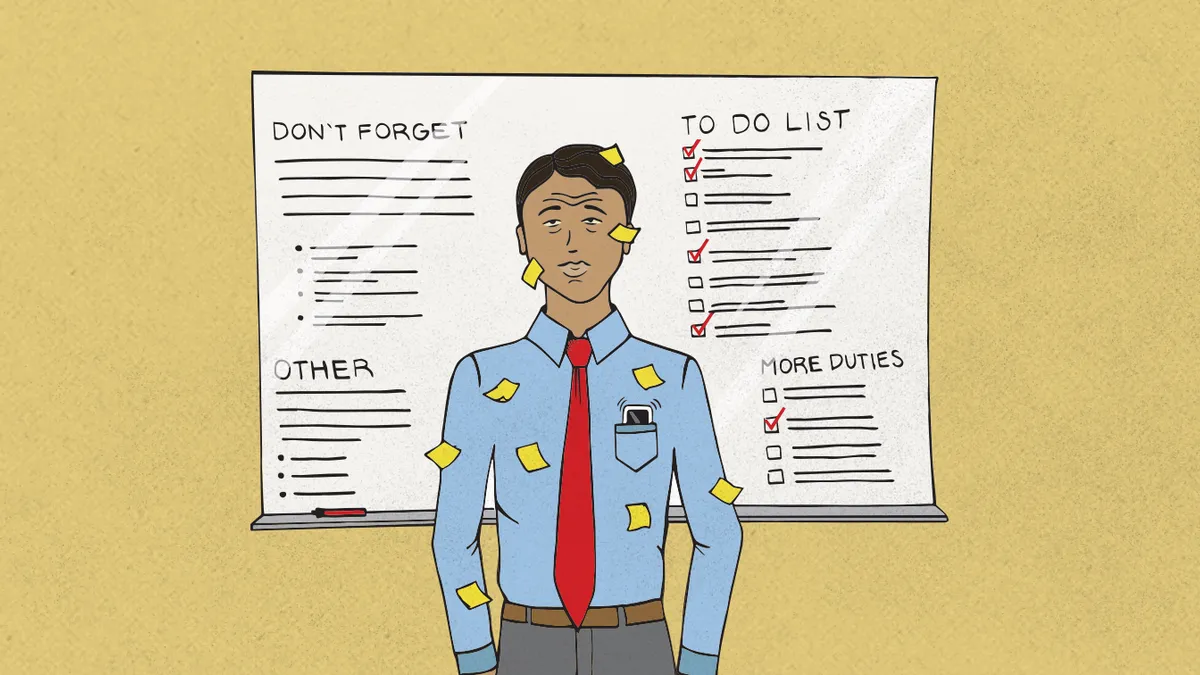In "Other Duties as Assigned," HR Dive's senior editor, Kate Tornone, weighs in on employment trends, compliance best practices and, of course, the situations that require you to go above and beyond your normal duties. Today: meeting the needs of the multigenerational workforce without stereotyping.
Editor's Note: This story is part of a series on the multigenerational workforce. The full package is available here.
As we discuss the differing preferences of the five generations that now make up the U.S. workforce, it’s easy to fall into the trap of stereotyping.
But when it comes to actually implementing engagement practices and offering benefits, that can’t be the case. It’s not only millennial dads that want leave to care for children; it’s not only Gen Z that wants to work as independent contractors; and it’s not only baby boomers who sometimes become complacent and start “playing to stay.”
Buying into these stereotypes and acting on them will not only rob you of the opportunity to see the best possible results from your engagement and retention initiatives, but also will set you up for a nice variety of discrimination claims.
A case study
Indulge me in a little trip back to the days before the Family and Medical Leave Act was enacted. My family was faced with an unexpected, serious health event: My little sister needed a liver transplant. None became available, but my dad was able to donate a part of his liver to her. (This story has a very happy ending, and I got to keep my only sister, now a really cool aunt to my son.)
At the time, I didn’t realize what a big deal it was, but my dad’s employer told him to take the time he needed — both for recovery from his surgery and to take care of my sister. But looking back, I now realize it was pretty extraordinary.
Holding his job for him was huge for my family, especially considering we were on the company’s health insurance. It also was good for the business, as my dad stayed there another five years, only leaving when the company was sold and moved out of state. And finally, it was good corporate citizenship, keeping a large, single-income family off of government assistance.
Mind your compliance
That experience is one of several reasons I remain unconvinced that the preferences we keep hearing about — millennials want paternity leave! Gen Z wants constant performance feedback! — have an entirely causal relationship with age.
My technically-a-boomer dad wanted leave to care for a child decades ago. This desire isn’t new; it’s just that we know it’s an option now, and it’s a little more ok to ask for it. When PwC’s millennial employees were clamoring for flexibility and leaving when they didn’t get it, the company conducted an internal survey. The resulting report concluded that “millennials want more flexibility, the opportunity to shift hours — to start their work days later, for example, or put in time at night, if necessary. But so do non-millennials, in equal numbers.” We all want the same things.
And as it becomes more acceptable to ask for these things (and as more employers grant these requests), the more employees are aware of their rights and willing to enforce them. Perhaps in the past, a man would back down when his manager suggested that his wife should care for a new baby or an aging parent, not having years of Title VII case law on his side. Today, however, we know that can amount to gender discrimination, and men are responding to those suggestions with lawsuits.
Additionally, while these demands may be a relatively new phenomenon, we’re only going to see them increase. As more women remain in the workforce (and more serve as their family’s primary breadwinner), men will necessarily have to take on more caregiving responsibilities than they have in the past. And this won’t affect only the men in relationships with these women; brothers who previously could rely on a homemaker sister to care for their aging parents will no longer be able to do so, for example. The same will happen as more men enter into relationships with other men; a gay couple will have no fewer child and parent caregiving responsibilities than any other couple with kids and parents.
There are myriad other “benefits of employment” to think about, too. We hear about Gen Z demanding to work when and where they want, flocking to independent contractor positions in droves. But according to recent research, it’s boomers driving the gig economy. If my mom shows up the next time you request a Lyft ride, ask her what she thinks. Independent contractor jobs are, of course, a different animal, but the flexibility lesson applies: If you’re only offering remote work to your youngest workers, for example, that’s certainly going to look like age discrimination to a jury.
The same goes for the feedback stereotype. Are you offering young employees regular coaching and training (because you read an HR Dive story saying that’s what they want) but leaving older workers to guess what you need from them? Yes, even negative feedback and discipline is a “benefit of employment” under the federal law. If you’re offering Gen Z opportunities to improve while leaving your boomers to wonder what went wrong following a termination, it’s time to brush up on your Age Discrimination in Employment Act requirements.
Shifting from stereotypes to personalization
I realize that, in a very broad sense, there may be some differences between the generations and the way they want to work.
But if your goal truly is to meet your employees’ needs, you need to ensure your offerings don't exclude anyone based stereotypes. Offer a flexible work arrangement to all the employees you can, not just those who you think might most appreciate it; remind your higher-ups that anyone can have caregiving responsibilities; allow managers and their reports to agree on the frequency of feedback that works for them.
In short, shift your focus from stereotypes to personalization.

















